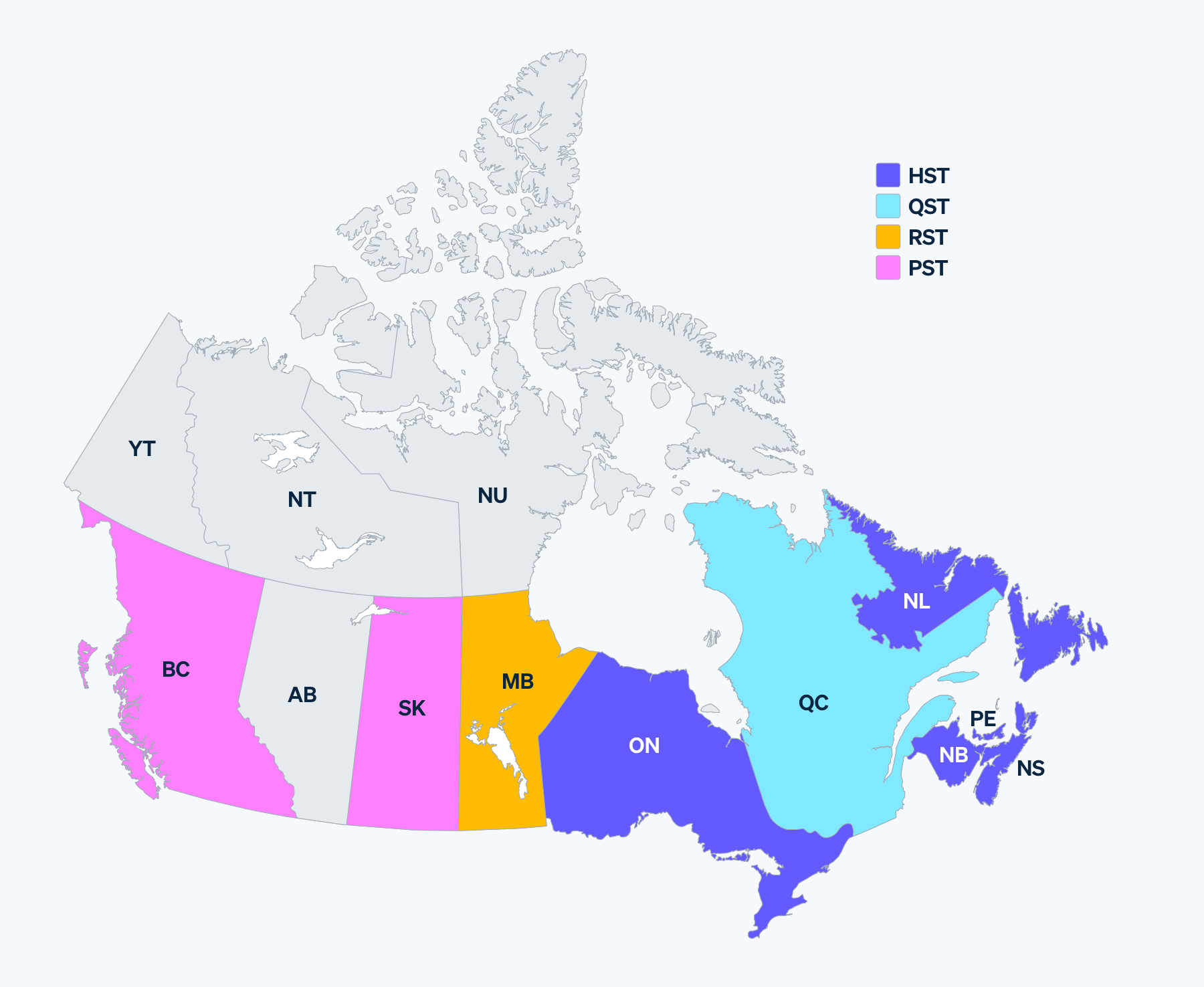ธุรกิจที่มีภาระภาษีในแคนาดามักต้องเผชิญกับการปฏิบัติตามข้อกำหนดหลายระดับ นอกเหนือจากภาษีสินค้าและบริการทั่วประเทศแล้ว ธุรกิจยังต้องพิจารณากฎระเบียบทางภาษีเฉพาะมณฑลด้วย เมื่อธุรกิจของคุณเติบโตขึ้น ก็ยังต้องมั่นใจด้วยว่าคุณยังติดตามข้อมูลภาระตามข้อกำหนดด้านภาษีที่เป็นปัจจุบันอยู่เสมอ ซึ่งเริ่มต้นด้วยการจดทะเบียนเพื่อเก็บภาษีอย่างถูกต้องในทุกที่ตั้งที่คุณมีภาระทางภาษี
คู่มือนี้จะช่วยคุณระบุว่าควรจดทะเบียนเพื่อเก็บภาษีตอนไหนเมื่อขายของไปที่แคนาดา เพื่อที่จะไม่ต้องเสียค่าปรับและดอกเบี้ยที่เกิดจากการไม่ปฏิบัติตามข้อกำหนด นอกจากนี้ยังช่วยให้ธุรกิจที่ไม่ใช่ผู้มีถิ่นพำนักสามารถดำเนินการผ่านกระบวนการจดทะเบียนภาษีในแต่ละมณฑลได้ และเราจะให้ข้อมูลดัวยว่า Stripe จะช่วยคุณจัดการการการปฏิบัติตามข้อกำหนดด้านภาษีอย่างต่อเนื่องได้อย่างไร
ภาษีสินค้าและบริการ (GST) ในแคนาดาคืออะไร
ระบบภาษีของแคนาดาประกอบด้วยภาษีระดับรัฐบาลกลางและระดับมณฑล ภาษีสินค้าและบริการ (GST) มีการใช้ทั่วประเทศ โดย 5 มณฑล ได้แก่ นิวบรันสวิก นิวฟันด์แลนด์และลาบราดอร์ โนวาสโกเชีย ออนแทรีโอ และเกาะพรินซ์เอ็ดเวิร์ด ได้ประสานภาษีขายของมณฑลกับ GST เพื่อนำระบบ Harmonized Sales Tax (HST) มาใช้ โดยระบบนี้ทำงานในลักษณะเดียวกับ GST ทำให้ธุรกิจในมณฑลเหล่านี้เก็บแค่ HST เพียงอย่างเดียวได้
ภาษีขายระดับมณฑลที่มีการเก็บแยกต่างหาก (PST) จะใช้ในบริติชโคลัมเบีย (BC) แมนิโทบา ควิเบก และซัสแคตเชวัน ในควิเบกเรียก PST ว่าภาษีขายควิเบก (QST) ในแมนิโทบาเรียก PST ว่าภาษีขายค้าปลีก (RST) ส่วนในซัสแคตเชวันและบริติชโคลัมเบียจะเรียกว่า PST ทั้งนี้ 4 มณฑล ได้แก่ อัลเบอร์ตา นอร์ทเวสต์เทร์ริทอรีส์ นูนาวุต และยูคอนไม่มีระบบภาษีขายระดับจังหวัด

แผนที่ภาษีระดับมณฑลที่แตกต่างกันในแคนาดา GST ใช้ทั่วประเทศ
หมายเลข GST คืออะไร
หมายเลขภาษีสินค้าและบริการ (GST) เป็นรหัสระบุที่ไม่ซ้ำกันที่ออกโดยหน่วยงานสรรพากรแคนาดา (CRA) ซึ่งเป็นรหัสระบุธุรกิจที่จดทะเบียนเพื่อเก็บและนําส่ง GST ในแคนาดา โดยขั้นตอนการจดทะเบียนเรียบง่ายและตรงไปตรงมา สามารถทำได้ทางออนไลน์ผ่านเว็บไซต์ของ CRA
การจดทะเบียนเพื่อเก็บภาษีในแคนาดา
ต้องจดทะเบียนเมื่อไร
ตามกฎทั่วไป ธุรกิจที่ไม่ใช่ผู้มีถิ่นพำนักซึ่งจำหน่ายสินค้าและบริการในแคนาดาต้องจดทะเบียนภาษีสินค้าและบริการ (GST) ของรัฐบาลกลางหากเข้าเกณฑ์ต่อไปนี้
- จัดหาสินค้าหรือบริการที่ต้องเสียภาษี (รวมถึงรายการที่ภาษีเป็นศูนย์) ในแคนาดา ในระหว่างดำเนินกิจกรรมทางธุรกิจในแคนาดา และไม่ใช่ผู้ประกอบการรายย่อย
- จัดหาบัตรเข้าชมที่ต้องเสียภาษีในแคนาดาสำหรับสถานที่พักผ่อนหย่อนใจ สัมมนา กิจกรรม หรืออีเวนต์ที่จัดขึ้นในแคนาดา (แม้ว่าจะเป็นผู้ประกอบการรายย่อยก็ตาม)
- จัดการประชุมในแคนาดาโดยตัวแทนผู้เข้าร่วมกว่า 25% เป็นผู้พํานักอาศัยในแคนาดา (แม้ว่าจะเป็นผู้ประกอบการรายย่อยก็ตาม)
ธุรกิจจะถือว่าเป็นผู้ประกอบการรายย่อยหากสินค้าหรือบริการที่จัดหาซึ่งต้องเสียภาษีทั่วโลกมีมูลค่าไม่เกิน 30,000 ดอลลาร์ในไตรมาสใดไตรมาสหนึ่งตามปฏิทินและใน 4 ไตรมาสปฏิทินที่ผ่านมาติดต่อกัน
ตั้งแต่วันที่ 1 กรกฎาคม 2021 มีข้อกำหนดพิเศษสำหรับธุรกิจในเศรษฐกิจดิจิทัล ธุรกิจที่ไม่ใช่ผู้พำนักซึ่งขายผลิตภัณฑ์หรือบริการดิจิทัลที่ต้องเสียภาษี และนิติบุคคลแคนาดาอื่นๆ ที่ไม่ได้จดทะเบียนในระบบ GST/HST ปกติ จะต้องจดทะเบียนหากมีรายรับเกิน 30,000 ดอลลาร์แคนาดาในช่วงเวลา 12 เดือน ธุรกิจดังกล่าวอาจใช้ขั้นตอนการจดทะเบียน GST/HST แบบง่าย ธุรกิจที่ต้องจดทะเบียน GST/HST แบบง่ายสามารถสมัครจดทะเบียน GST/HST ปกติได้โดยสมัครใจหากเข้าเงื่อนไขบางประการ
ธุรกิจอาจต้องการจดทะเบียน GST/HST แบบง่าย เพราะรายงานและนำส่ง GST/HST ที่เก็บได้ง่ายกว่า โดยต่อไปนี้คือข้อดีบางส่วนของขั้นตอนการจดทะเบียนแบบง่าย
- คุณไม่จำเป็นต้องจ่ายเงินมัดจำกับหน่วยงานภาษีแบบเดียวกับผู้ที่ไม่ใช่ผู้พำนักที่จดทะเบียน GST/HST ต้องทำตามปกติ
- การชำระเงิน (การนำส่ง) จะทำรายไตรมาสตามรอบรายงานของไตรมาสปฏิทินของคุณ สำหรับธุรกิจที่ไม่ใช้ขั้นตอนการจดทะเบียนแบบง่าย ความถี่ในการยื่นจะขึ้นอยู่กับ ยอดขาย
- คุณสามารถสมัครขออนุญาตชำระเงินในสกุลต่างประเทศที่อนุญาตให้ชำระได้
- ภาษีสุทธิที่คุณจะต้องคำนวณและรายงานจะถูกทำให้ง่ายขึ้นเนื่องจากคุณจะไม่ได้รับอนุญาตให้เคลมเครดิตภาษีซื้อ (ITC)
วิธีการลงทะเบียนเพื่อเก็บภาษีในแคนาดา
ก่อนที่คุณจะเก็บ GST และภาษีแคนาดาอื่นๆ คุณต้องจดทะเบียนกับหน่วยงานภาษีที่ถูกต้อง โดยคุณสามารถลงทะเบียน GST/HST แบบง่ายออนไลน์ได้ ทั้งนี้ควรทราบไว้ว่าธุรกิจอาจไม่ถึงเกณฑ์ต้องจดทะเบียนภาษีในระดับประเทศ แต่ยังคงต้องจดทะเบียนเพื่อเก็บภาษีระดับมณฑล
หากรายรับของคุณเกินเกณฑ์ภาษีในแคนาดาและกังวลว่าจะต้องจ่ายค่าปรับและภาษีย้อนหลัง เราขอแนะนำให้คุณติดต่อขอรับคำแนะนำจากผู้เชี่ยวชาญด้านภาษี เมื่อจดทะเบียนแล้วคุณจึงจะเริ่มเก็บภาษีได้ อย่าเริ่มเก็บภาษีก่อนที่จะจดทะเบียนอย่างถูกต้อง
การลงทะเบียนเพื่อเก็บภาษีในบริติชโคลัมเบีย
ต้องจดทะเบียนเมื่อไร
มณฑลบริติชโคลัมเบียกำหนดให้ธุรกิจขายสินค้าหรือบริการที่ต้องเสียภาษีในมณฑล รวมถึงซอฟต์แวร์และบริการโทรคมนาคม ต้องลงทะเบียนเพื่อเก็บ PST หากรายรับรวมจากการขายที่ต้องเสียภาษีและที่ยกเว้นภาษีทั้งหมดให้กับลูกค้าในบริติชโคลัมเบียใน 12 เดือนที่ผ่านมา มากกว่า 10,000 ดอลลาร์แคนาดา หรือคาดว่ารายรับจะเกินจำนวนนี้ในอีก 12 เดือนถัดไป
ตามเกณฑ์ GST ของรัฐบาลกลางและเกณฑ์ของแต่ละมณฑล ผู้ขายต้องจัดทำบันทึกรายได้ที่ถูกต้องและชัดเจนเพื่อให้แน่ใจว่าเก็บภาษีได้อย่างถูกต้อง ตัวอย่างเช่น หากผู้ขายในบริติชโคลัมเบียมีการขายเกิน 10,000 ดอลลาร์แคนาดา แต่ต่ำกว่า 30,000 ดอลลาร์แคนาดา (เกณฑ์ GST) ผู้ขายจะไม่ต้องจดทะเบียนเพื่อเก็บ GST แต่จดทำเบียนแค่ PST อย่างไรก็ตาม หากผู้ขายคาดว่ารายรับจะเกินเกณฑ์ภาษีของรัฐบาลกลางใน 12 เดือนถัดไป ผู้ขายจะต้องจดทะเบียน GST/HST
วิธีการจดทะเบียนเพื่อเก็บภาษีในบริติชโคลัมเบีย
ก่อนที่คุณจะเก็บ PST คุณต้องจดทะเบียนกับหน่วยงานด้านภาษีที่ถูกต้อง โดยสามารถจดทะเบียนเพื่อเก็บ PST ทางออนไลน์ได้
หากรายรับของคุณเกินเกณฑ์ภาษีในแคนาดาและกังวลว่าจะต้องจ่ายค่าปรับและภาษีย้อนหลัง เราขอแนะนำให้คุณติดต่อขอรับคำแนะนำจากผู้เชี่ยวชาญด้านภาษี เมื่อจดทะเบียนแล้วคุณจึงจะเริ่มเก็บภาษีได้ อย่าเริ่มเก็บภาษีก่อนที่จะจดทะเบียนอย่างถูกต้อง
การจดทะเบียนเพื่อเก็บภาษีในแมนิโทบา
ต้องจดทะเบียนเมื่อไร
ธุรกิจแคนาดานอกแมนิโทบาและธุรกิจในต่างประเทศที่ส่งมอบทรัพย์สินส่วนบุคคลที่จับต้องได้ไปยังแมนิโทบาหรือเสนอขายและรับการขายในมณฑลต้องจดทะเบียนเพื่อเก็บ RST ทั้งนี้ตั้งแต่วันที่ 1 ธันวาคม 2021 แมนิโทบาได้ขยายอำนาจการเก็บภาษีให้ครอบคลุมการขายบริการดิจิทัลที่ดำเนินการโดยผู้ขายนอกมณฑล ใครก็ตามที่ทำธูรกิจแพลตฟอร์มที่พักออนไลน์หรือแพลตฟอร์มการขายออนไลน์หรือให้บริการสตรีมมิงต้องจดทะเบียนเพื่อเก็บ RST เนื่องจากไม่มีการกำหนดเกณฑ์ความเชื่อมโยงทางเศรษฐกิจสำหรับผู้ขายนอกมณฑลเอาไว้ ผู้ขายเหล่านี้จึงต้องจดทะเบียนตั้งแต่การขายครั้งแรก
วิธีการจดทะเบียนเพื่อเก็บภาษีในแมนิโทบา
ก่อนที่จะเก็บ RST คุณต้องจดทะเบียนกับหน่วยงานภาษีที่ถูกต้อง โดยสามารถจดทะเบียนเพื่อเก็บ RST ออนไลน์ได้
หากรายรับของคุณเกินเกณฑ์ภาษีในแคนาดาและกังวลว่าจะต้องจ่ายค่าปรับและภาษีย้อนหลัง เราขอแนะนำให้คุณติดต่อขอรับคำแนะนำจากผู้เชี่ยวชาญด้านภาษี เมื่อจดทะเบียนแล้วคุณจึงจะเริ่มเก็บภาษีได้ อย่าเริ่มเก็บภาษีก่อนที่จะจดทะเบียนอย่างถูกต้อง
การจดทะเบียนเพื่อเก็บภาษีในซัสแคตเชวัน
ต้องจดทะเบียนเมื่อไร
ธุรกิจแคนาดานอกซัสแคตเชวันและธุรกิจนอกแคนาดาที่ค้าปลีกเพื่อการใช้หรือบริโภคในซัสแคตเชวันต้องจดทะเบียนเพื่อเก็บ PST ทั้งนี้ไม่มีเกณฑ์ความเชื่อมโยงทางเศรษฐกิจสำหรับผู้ที่ไม่ใช่ผู้พำนักในซัสแคตเชวัน ซึ่งหมายความว่าต้องมีการเก็บ PST 6% ตั้งแต่ธุรกรรมแรก แนวทางนี้ใช้กับผลิตภัณฑ์ดิจิทัลหลายประเภท เช่น การดาวน์โหลดเสียงและวิดีโอดิจิทัล ซอฟต์แวร์ บริการซอฟต์แวร์ และบริการประเภทคลาวด์
วิธีการจดทะเบียนเพื่อเก็บภาษีในซัสแคตเชวัน
ก่อนที่จะเก็บ PST คุณต้องจดทะเบียนกับหน่วยงานเก็บภาษีที่ถูกต้อง คุณสามารถจดทะเบียนเพื่อเก็บ PST ออนไลน์ผ่านลิงก์นี้
หากรายรับของคุณเกินเกณฑ์ภาษีในแคนาดาและกังวลว่าจะต้องจ่ายค่าปรับและภาษีย้อนหลัง เราขอแนะนำให้คุณติดต่อขอรับคำแนะนำจากผู้เชี่ยวชาญด้านภาษี เมื่อจดทะเบียนแล้วคุณจึงจะเริ่มเก็บภาษีได้ อย่าเริ่มเก็บภาษีก่อนที่จะจดทะเบียนอย่างถูกต้อง
การจดทะเบียนเพื่อเก็บภาษีในควิเบก
ต้องจดทะเบียนเมื่อไร
ผู้ที่ไม่ได้เป็นผู้พํานักอาศัยในควิเบกสามารถจดทะเบียนภายใต้ระบบที่กําหนดหรือระบบทั่วไปได้ ผู้ขายในหมวดต่อไปนี้ที่ไม่ใช่ผู้พำนักอาศัยในควิเบกต้องใช้ระบบที่กำหนดให้หากมียอดขายที่ต้องเสียภาษีในควิเบกเกิน 30,000 ดอลลาร์แคนาดาในระยะเวลา 12 เดือน
- ผู้ขายนอกแคนาดาที่ขายสังหาริมทรัพย์ที่จับต้องไม่ได้หรือบริการในควิเบก
- ผู้ขายนอกควิเบกที่ขายสังหาริทรัพย์ที่จับต้องได้ สังหาริมทรัพย์ที่จับต้องไม่ได้ หรือบริการแก่ผู้บริโภคในควิเบก
วิธีจดทะเบียนเพื่อเก็บภาษีในควิเบก
คุณต้องจดทะเบียนกับหน่วยงานภาษีที่ถูกต้องก่อนที่จะเก็บ QST ออนไลน์
หากรายรับของคุณเกินเกณฑ์ภาษีในแคนาดาและกังวลว่าจะต้องจ่ายค่าปรับและภาษีย้อนหลัง เราขอแนะนำให้คุณติดต่อขอรับคำแนะนำจากผู้เชี่ยวชาญด้านภาษี เมื่อจดทะเบียนแล้วคุณจึงจะเริ่มเก็บภาษีได้ อย่าเริ่มเก็บภาษีก่อนที่จะจดทะเบียนอย่างถูกต้อง
Stripe Tax ช่วยอะไรได้บ้าง
Stripe ช่วยมาร์เก็ตเพลสต่างๆ สร้างและขยายธุรกิจการชำระเงินและบริการทางการเงินระดับโลกที่ทรงประสิทธิภาพได้ โดยใช้เวลาการทำงานน้อยลงและมีโอกาสในการเติบโตมากขึ้น Stripe Tax ลดความซับซ้อนในการปฏิบัติตามข้อกำหนดด้านภาษีทั่วโลก เพื่อให้คุณมีเวลาทุ่มเทกับการพัฒนาธุรกิจให้เติบโต โดยระบบจะคำนวณและเก็บภาษีการขาย ภาษีมูลค่าเพิ่ม และภาษี GST โดยอัตโนมัติจากทั้งสินค้าที่จับต้องได้และสินค้าดิจิทัล รวมไปถึงบริการในทุกรัฐของสหรัฐอเมริกาและอีก 100 ประเทศ Stripe Tax สร้างขึ้นภายใน Stripe โดยเฉพาะ และช่วยให้คุณเริ่มใช้งานได้รวดเร็วขึ้นโดยที่ไม่ต้องมีการผสานการทำงานหรือใช้ปลั๊กอินของบริษัทอื่น
Stripe Tax ช่วยคุณทำสิ่งต่อไปนี้ได้
- ทำความเข้าใจว่าต้องจดทะเบียนและเรียกเก็บภาษีที่ไหน: ดูประเทศที่คุณอาจต้องเรียกเก็บภาษีตามธุรกรรม Stripe หลังจากจดทะเบียนแล้ว คุณสามารถปิดใช้การเรียกเก็บภาษีในรัฐหรือประเทศใหม่ได้ในไม่กี่วินาที คุณจะเริ่มเรียกเก็บภาษีได้โดยเพิ่มโค้ดเพียงบรรทัดเดียวลงในการผสานการทำงาน Stripe ที่ใช้อยู่ หรือเพิ่มการเรียกเก็บภาษีลงในผลิตภัณฑ์ Stripe ที่ไม่ต้องเขียนโค้ด เช่น Invoicing ด้วยการคลิกเพียงปุ่มเดียว
- จดทะเบียนชำระภาษี: หากคุณมีธุรกิจอยู่ในสหรัฐอเมริกา สามารถให้ Stripe จัดการการจดทะเบียนภาษีแทนคุณ ช่วยกรอกรายละเอียดการสมัครล่วงหน้าและรับประโยชน์จากขั้นตอนที่ง่ายขึ้น ถ้าคุณอยู่นอกประเทศสหรัฐอเมริกา Stripe พารท์เนอร์กับ Taxually ในการจดทะเบียนภาษีกับสำนักงานสรรพากรในพื้นที่ ให้คุณประหยัดเวลาและปฏิบัติตามระเบียบข้อบังคับท้องถิ่นได้ง่ายขึ้น
- เก็บภาษีการขายโดยอัตโนมัติ: Stripe Tax จะคำนวณและเก็บภาษีตามจำนวนที่ค้างชำระ โดยรองรับสินค้าและบริการหลายร้อยรายการ ทั้งยังมีข้อมูลล่าสุดเกี่ยวกับกฎและการเปลี่ยนแปลงอัตราภาษี
- ทำให้การยื่นและนำส่งเป็นเรื่องง่ายขึ้น: พาร์ทเนอร์ทั่วโลกที่ได้รับความไว้วางใจของเราจะช่วยให้ผู้ใช้ได้รับประสบการณ์ที่ราบรื่นซึ่งเชื่อมต่อกับข้อมูลธุรกรรมใน Stripe ของคุณ ให้พาร์ทเนอร์ของเราช่วยจัดการการยื่นเอกสารให้คุณ เพื่อให้คุณมีเวลาไปมุ่งเน้นในการพัฒนาธุรกิจให้เติบโต
ดูข้อมูลเพิ่มเติมเกี่ยวกับ Stripe Tax